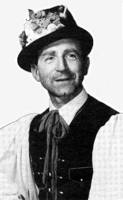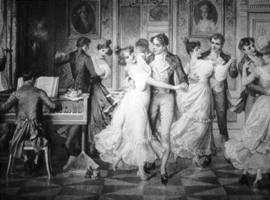
|
The Society of Folk Dance Historians (SFDH)
Viennese Waltz
[
Home |
About |
Encyclopedia | CLICK AN IMAGE TO ENLARGE |

|
 The Viennese Waltz is probably the most international of all dances. The step is the true waltz (step, step, close) with the accent on the first of six beats. The music is in 3/4 time. In order to get the true Viennese flavor, be sure to buy only records that carry the notation "Recorded in Europe."
The Viennese Waltz is probably the most international of all dances. The step is the true waltz (step, step, close) with the accent on the first of six beats. The music is in 3/4 time. In order to get the true Viennese flavor, be sure to buy only records that carry the notation "Recorded in Europe."
The waltz should be learned right and turning left, but after the step has been conquered, the accomplished Viennese Waltz couple should dance turning to the left only, interrupted by an occasional running waltz step, where the music indicates it.
As the only variation in the Viennese Waltz is the change of tempo, it is important to listen carefully to the music, to take larger steps and to turn less vigorously when the music slows down. When there is a break in the music, take running steps (waltz), forward for the men, backward for the women. No two Viennese Waltz dances are alike in tempo, therefore no definite routine (how many steps per turn) can be established. Listen to the music and dance accordingly.
It is important for the man to give a firm and strong lead to his partner, to keep the ballroom position firm and steady, to support each other by holding hands firmly at the partner's shoulder blades, to give and take in the turning, to be always face-to-face (avoiding sideslipping), to move smoothly with your entire body and not sway the upper part of the body separately from the lower part, and to find your own method of how not to get dizzy.
DOCUMENTS
- Cowboy Waltz, an article.
- History of the Waltz, an article.
- Waltz, One Step, and Tango Partnering Tips, an article.
Reprinted from the 1949 College of the Pacific (Stockton) Folk Dance Camp syllabus.
This page © 2018 by Ron Houston.
Please do not copy any part of this page without including this copyright notice.
Please do not copy small portions out of context.
Please do not copy large portions without permission from Ron Houston.